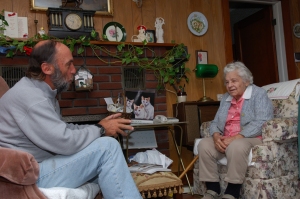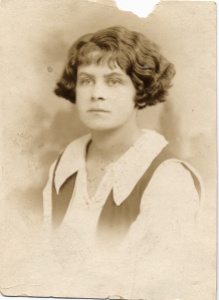A wonderful Friend has passed

While we were traveling north through the Richelieu River valley, word arrived that Cora, a very special friend to all who have an interest in canal life, had passed. Cora was in her 108th year when her time came, and the news was received with a mixture of sadness and relief.

I met Cora some years ago when she was a spry woman in her mid-90’s. I heard that she had been raised on a wooden canal boat and was willing, even eager, to talk about her own and her family’s experiences. When LCMM researcher Jane Vincent returned from a visit to Cora with an audio tape filled with sharp, thoughtful recollections and insights that only someone who lived the life would have, I knew that I needed to meet Cora.
Cora lived on Fiddler’s Elbow, a familiar and important landmark just north of Whitehall Village. The Elbow was the hard turn to the west that mariners made for generations to get into the old channel that completed the journey to Whitehall. That sharp turn, sometimes only accomplished by running a line ashore, was only improved when the “new” canal was completed in 1918. In years past, I had worked and dived in the area of the Elbow, Old Channel, and the Poultney River, looking for and documenting abandoned shipwrecks from the War of 1812 and the commercial era. Visiting Cora for the first time involved a land approach that culminated literally at the very last house on Fiddler’s Elbow. Cora lived in a small house her father had built for her on the site of the old Henry Neddo shipyard, a facility that built and repaired many canal boats.
While the location was historically interesting, it was Cora’s incredible recollections that made the visits to see her so very special. Cora told me that she was motivated to speak of the canal days to preserve memories of her family, particularly of her mother, Isobel. Cora was able to answer my questions with many details that had escaped the written, artistic, or photographic record. What was it like in the family cabin? Where did you and your sisters and brothers sleep and play? What kind of pets did you have? What cargos did your father haul? What was it like during the war (World War I) years? Cora told stories of everyday travel, as well as a series of dramas like the time her younger sister Viola fell into the water at Sorel. Cora’s mother heard the other children scream and, despite the fact that she couldn’t swim, Isobel jumped into the water to save her. The screams woke up her father Francois (Frank) who, “quick as a cat,” dove into the water and saved them both. To Cora, for this and other acts of courage, her father was always an unsung hero. I went to visit Cora often, recording her stories and recollections. A more generous spirit I have never met.
I remember being intrigued by Cora’s explanation of filling up the canal boat’s drinking water barrels on Lake Champlain: “When we got to Lake Champlain, way out the water was beautiful and clear, and they would send back word ‘Don’t anybody empty your slop buckets or throw anything in the water because we’re going to fill the water barrels.’ They filled the fixed barrels with buckets over the side.” I asked Cora what a slop bucket was and she laughed and told me it was another word for chamber pot, the traditional way of providing the people on board with bathroom access. Cora then asked me if I wanted to see the family slop bucket, which she still had in her garage, and, of course, I did. I so admired the small porcelain bucket and the role it played in everyday life aboard the canal boat that Cora asked if I might want it for the museum. Today, the slop bucket and the family’s cabin oil lamp, also a gift from Cora, are on display at the museum for all to see.

Even after I had interviewed Cora many times and felt I had captured the wealth of her stories, I could not end the visits. I still went back to see her, knowing I was in the presence of a very special person. She had become, not only a teacher about the canal age, but a close friend. Cora was so unassuming and always made me feel special. If I tried to explain why I loved to visit her she would dismiss the praise and quickly change the subject. I often brought my son Nathan or a friend to meet her. In 2004, Jane Vincent and I were honored to be invited to attend Cora’s 100th birthday party, a family celebration that showed how much they loved her. When the Lois McClure paid its inaugural visit to Whitehall, we arranged to have Cora come on board, which was made even more special by providing an opportunity for Lois McClure (herself) and Cora to meet. In subsequent years, every time we would pass Cora’s house on Fiddler’s Elbow, I would call ahead to let her know that I would sound the tugboat’s horn when we went by. The crew, who knew Cora’s story, would all wave. I remember when we were going out the Erie Canal for the first time, she told me to be careful on Oneida Lake because it could get very rough. She also recounted the fun she had with her siblings at the amusement park at Sylvan Beach.
I think it was two years ago when we were going to pass by Fiddler’s Elbow on our way to the Erie that I couldn’t raise Cora on the phone. I called her great-niece and neighbor, April, and learned that for Cora, living alone on the Elbow, even with April’s help, had become just too difficult. She was now at an assisted living facility in Granville, NY. I visited Cora there several times and found her well taken care of by the staff who seemed to recognize they had a very special person in their midst.
Cora’s recollections begin in the days when horses and mules still pulled wooden boats along a towpath, and she witnessed the transition to the enlarged New York State Barge Canal that replaced horses with tugboats.

For me, beyond the many priceless recollections of days gone-by that enrich our understanding of the canal and allow us to share her family’s story with the public, I remember a sweet, unassuming, wonderful person, always more concerned for others than for herself. I will think of her often, especially whenever I am lucky enough to be traveling with Lois on the canal and especially when we pass by the Fiddler’s Elbow. Rest in peace Cora, all who knew you, loved you.
Art Cohn
Captain, C.L.Churchill

Thanks Art for this wonderful story about a wonderful lady. And thanks for preserving her past.
Pingback: Captain’s Log, Part 2 | Lake Champlain Maritime Museum
Pingback: Captain’s Log, Part 2 - Lake Champlain Life
Pingback: 'Lois McClure': Captain's Log: Part 2
Pingback: Captain’s Log, Part 7 | Lake Champlain Maritime Museum
Pingback: 'Lois McClure': Captain’s Log, Part 7
Pingback: Captain’s Log, Part 8 | Lake Champlain Maritime Museum